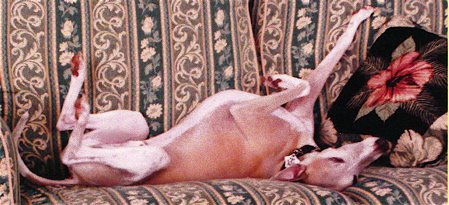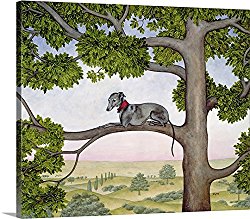| Back to Back Issues Page |
 |
|
The Whippeteer: Whippet Dog News, Issue #75 - Dog Dental Care February 04, 2017 |
HighlightsWhippet Stories Chicken soup for the whippet lover's soul. What is like to live with the fastest couch potatoes on earth? How does it feel to share your sofa with a dog that consistently outsmarts you? Short stories of a traveling family and its whimsical whippets. The Whippet of the Day Your whippet can be Dog of the Day! Send us your favorite pics and find your whippet on our home page! Whippet Poems Send us your most inspired poems. The best rhymes will have a special place in our website! Whippet Car Sickness Survival Guide Lame Whippet A limping whippet is a sorry sight. After testing, investigating and spending a small fortune we found the cause of our whippet’s lameness. News and ArticlesWestminster: Meet the New Breeds How to Teach Your Dog the “Stop Barking” Command Driving with your dog, safely. Walnut The Whippet Joined By Hundreds Of People On Final Walk Radish The Ball-Bopping Whippet 14 Reasons Whippets Are The Worst Indoor Dog Breeds Of All Time Four basic rules for walking dogs in coyote territory I am not a Dog Park advocate. The Dog Show Game – Telling It Like It Is The Calming Signals Most Humans Miss From Their Pets Whippet Art
Rosie Ditz Premium Thick-Wrap Canvas Wall Art Print entitled The Tree Whippet Featured ArticleDog Dental CareDental care is one of the most important factors in maintaining good dog health. The domesticated dog is living much longer and in a contemporary life style that has changed dog nutrition making dental and oral disease the number one problem that veterinarians treat. This article first explains the canine dental and oral makeup and the basics of a good canine dental care program. It is not as simple as cleaning dog teeth. Dog Health Starts With Good Dental Care
Just as in humans with modern preventive medicine including everything from x-rays, vaccinations, heartworm treatments to spraying and neutering along with more education and better communication on how to diagnose and treat many ailments, viruses, and diseases domesticated dogs are living longer than just the recent past. Dogs living in the United States experience an average life of almost 13 years. As an interesting side note the long time belief that one dog year equals 7 human years is really incorrect. Dogs do age much faster than humans but not at a linear rate. A more accurate estimate is to count the 1st dog year as 15 human years, the 2nd as 24 years and years 3 and beyond as 4 humans years. With this longer life span and present day dog nutrition contemporary domesticated dogs are experiencing the same rise in diseases as humans such as cancer, diabetes, heart problems, arthritis, and dental problems. Most veterinarians rank dental and oral disease as the number one health problem that they examine. This fact gives notice to dog owners to develop and provide a good dental care program for their pets. It is more than just cleaning dog teeth. It requires a consistent and thorough daily effort that involves both care at home and at the veterinarian office. The modern day dog owner is constantly attempting to turn their dog into a human. Through these contemporary life styles of pets and their owners the dog has been removed further and further away from their natural wild environment. These drastic domesticated changes in both the life style and diet of the natural dog have removed critical components needed by their digestive system which starts in the mouth. The differences between humans and dogs start right there. Human saliva in the mouth contains the enzyme amylase. This gets the human digestive process started by breaking down starchy foods into sugar before they leave the mouth. Since wild dogs did not eat starches their saliva does not contain amylase. Thus when the modern day dog's diet contains large amounts of starch it has the propensity to stick to the teeth. If not removed in a timely and consistent manner this causes plaque and tartar build up which can lead to gum disease and seriouly affect dog health. Studies show that by age three, 80 percent of dogs show evidence of gum disease. Persistent bad breath is the easiest and most recognizable symptom. The bad breath or Halitosis starts out mild with just bacteria caused from tarter and plaque buildup but quickly becomes very unpleasant with the development of gingivitis and almost intolerable with the advance to periodontal disease. At this point the tarter buildup actually creates space between the gums and the teeth allowing increased bacterial growth that results in abscesses, lost teeth, bone lost, and deadly infections. Other then bad breath signs to look for include excess tarter and plaque buildup which results in yellow and brown colored teeth along the gum line and inflamed red gums. One good thing is that as in humans cavities caused by the sugar are not a concern in dogs. Dog's saliva does contain the bacteria killing enzyme lysozyme. This again comes from their wild environment of needing to eat rotted and rancid meats were humans purify and cook their food. As you will learn below dogs do not actually chew their food. They grab, hold, tear, and shred it into large pieces. The saliva you see when a dog is anxiously waiting to eat only has one purpose as a lubricant for swallowing. Once again remembering that dogs are carnivorous from the wild evolving from wolves were the wild packs have to eat quickly grabbing, tearing, shredding and gulping the food down in large chunks and leaving in hurry. This leads to the most visual and profound difference between dogs and human---the teeth. First the dog's jaw is hinged and even though it cannot move sideways as the human jaw it does open wider to allow larger chunks of food to be consumed. It does not move sideways since the food is ripped and shredded not ground like corn. The teeth are quite different from human teeth. First there are 42 instead of 32. Just like humans, dogs have two sets of teeth in their life time. The 28 baby (or puppy) teeth start to emerge at the third week with permanent adult replacement beginning in the fourth month. There are 6 incisive and 2 canine teeth in both the top and lower rows. The upper rows have a total 8 premolars and 4 molars while there are 8 premolars and 6 molars on the bottom. The incisive teeth are used to nibble and shed food. The premolars cut and rip large chunk of food. These premolars are the teeth dogs use to chew on rawhide and other dog toys. The canine (Fang) teeth are used to grab, hold objects and if necessary in defense. The molars are used to crush bones and hard biscuits. The basic tooth structure in relation to the crown, pulp, roots, etc are basically the same as human teeth so canine dental care and treatment are similar and equally effective--clean dog teeth is just as important in dogs as it is in humans. A good canine dental program consist of regular veterinarian visits which should include a detailed oral exam and if advised a dental cleaning. But more important daily home dental care is essential. This starts with a proper diet and dog nutrition. Feeding high quality kibbled foods and hard biscuits help scrub and keep the teeth clean. Soft foods and foods high in starch should be eliminated or minimized. There are special treats and foods on the market that are approved and recommended by dental veterinarians and the American Veterinary Medical Association (AVMA) that have proven effective in several studies. Dog chewing toys such as dental bones, rawhide, and hard rubber dental plaque removers are also very helpful in keeping your dog's teeth clean. Frequent home oral exams of the dog's mouth including gums and teeth need to be performed. Watch for early warning signs such as bad breath, yellow and brown teeth, red and swollen gums, and obviously any missing or damaged teeth. Also examine the mouth in general for unusual lumps or masses. The same goes for the face in general looking for swelling, discharges, irregularities, or unevenness. And last but not least just as in humans a good daily cleaning and bushing. Make sure to use a proper approved tooth paste for dogs. Over the counter human tooth paste is not recommend and can actually make the dog sick. This type of attention to the dog's teeth and mouth helps insure good overall dog health. It will save money in the long run. The average cost of a veterinarian complete teeth cleaning is reported to be almost $300 it does not have to be performed that often if a good home dental program is established. Daily bushing, dog treats, and dental toys average less than $100 per year and a good dental diet of proper dog food is about $250 dollars a year which is just part of the normal dog feeding cost. Advanced periodontal diseases can easily cost $1000s of dollars to treat. Article Source: https://EzineArticles.com/expert/Bruce_Harte/683213
Visit the TheWhippet.net frequently as we are constantly updating our site with information, resources and tips for the dog lover. I would like to thank here all our readers whether they are regular visitors or new to the site and especially all the contributors to our pages. They all made my job more rewarding and our site more interesting for everyone.
All your contributions are really appreciated! Visit us soon at TheWhippet.net! |
| Back to Back Issues Page |

